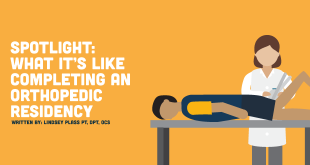Total Knee Replacement Physical Therapy: Every Case is Unique
All right, clinicians, put your goniometers down. Forget everything you’ve conventionally thought about the knee joint, and open your minds to the idea that the hip and ankle are your best bets to help create your total knee replacement physical therapy plans of care and prognoses.
Traditional physical therapy assessment tools, such as active and passive ROM, limb/posture alignment, accessory mobility, and manual muscle tests, all exist for a reason.
These assessment tools play a role in benchmarking a patient’s objective progress, but they are not always linked to gains in functional tasks. Squatting, walking, and stair climbing require the entire kinetic chain to function well, so your assessments and treatments should take this into consideration.
Knee osteoarthritis (OA) is usually what brings a patient into the doctor’s office, frustrated and ready to decide on elective total knee replacement.
- Mechanically, the hip often sits in an adducted position, and the ankle is unable to effectively pronate.
- This can cause the tibia to stay externally rotated on an internally rotating femur.
- The end result is unwanted torsional forces at the knee, advancement of OA, and the patient’s pain response.
This is where thinking outside of the box as a clinician is vital. We must stay focused on individual care and remain “patient-centered,” rather than taking a “cookie cutter” approach.
Realistic expectations are key
If the compensatory impairments at the hip and ankle are identified early, a patient can better understand what he or she is up against during the recovery process. If these impairments are caught early, through pre-operative screening, or during routine doctor’s office visits, or even through public education programs, the patient might even be able to address the impairments during “prehab.” This can help cut recovery time.
At the very least, it can help the patient and physician understand that this patient’s total knee replacement physical therapy process might take longer than expected.
Debunking the myths
We, as PTs, need to fight the misconception that total knee replacement recovery is a uniform process, by informing the patient and physician as early as possible about the big picture. A patient usually waits for many painful years (often until the knee joint is bone on bone) to finally decide on surgery. All this time, compensations in the knee and hip are created. Many patients also expect that after getting a ‘new’ knee, they will immediately have a new lease on life. The reality is that the post-operative pain process can be lengthy, depending on pre-existing factors.
This will ensure optimum teamwork.
And it will mean that nobody is caught off guard by lurking predictive factors that can negatively affect the patient’s physical therapy after a total knee replacement.
 NewGradPhysicalTherapy.com The Largest Online Resource For New Grad Physical Therapists
NewGradPhysicalTherapy.com The Largest Online Resource For New Grad Physical Therapists






